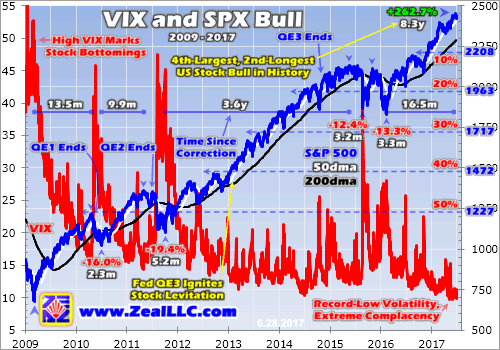The US stock markets have enjoyed an extraordinary surge this year, shattering all kinds of records. It’s been fueled by hopes for big tax cuts soon from Trump’s Republican government. But such relentless rallying has catapulted complacency, euphoria, and valuations to dangerous bull-slaying extremes. This has left today’s beloved and lofty stock markets hyper-risky, with mounting potential for serious selloffs erupting.
History extensively proves that stock markets are forever cyclical, no trend lasts forever. Great bulls and bears alike eventually run their courses and give up their ghosts. Sooner or later every secular trend yields to extreme sentiment peaking, then the markets inevitably reverse. Popular greed late in bulls, and fear late in bears, ultimately hits unsustainable climaxes. All near-term buyers or sellers are sucked in, killing the trend.
This mighty stock bull born way back in March 2009 has proven exceptional in countless ways. As of mid-June, the flagship S&P 500 broad-market stock index (SPX) has powered 262.7% higher over 8.3 years! Investors take this for granted, but it’s far from normal. That makes this bull the fourth-largest and second-longest in US stock-market history! And the few superior bull specimens vividly highlight market cyclicality.
The SPX’s biggest and longest bull on record soared 417% higher between October 1990 and March 2000. After it peaked in epic bubble-grade euphoria, the SPX soon yielded to a brutal 49% bear market over the next 2.6 years. The SPX wouldn’t decisively power above those bull-peaking levels until 12.9 years later in early 2013, thanks to the Fed’s unprecedented QE3 campaign! The greatest bull didn’t end well at all.
The second-largest bull was a 325% monster between July 1932 to March 1937. But that illuminated the inexorable cyclicality of stock markets too, as it arose from the ashes of a soul-crushing 89% bear in the aftermath of 1929’s infamous stock-market crash. The third-largest bull was 266% from June 1949 to August 1956, which we’ve almost surpassed. And even that post-WW2 boom was followed by another bear.
All throughout stock-market history, this binary bull-bear cycle has persisted. Though some bulls grow bigger and last longer than others, all eventually give way to subsequent bears to rebalance sentiment and valuations. So stock investing late in any bull market, which is when investors complacently assume it will last indefinitely, is hyper-risky. Bear markets start at serious 20% SPX losses, and often approach 50%!
Popular psychology in peaking bull markets is well-studied and predictable. Investors universally believe “this time is different”, that some new factor leaves their bull impregnable and able to keep on powering higher indefinitely. This new-era mindset fuels extreme euphoria and complacency, with memories of big selloffs fading. Investors’ hubris swells, as they forget markets are cyclical and ridicule any who dare warn.
To any serious student of stock-market history, there’s little doubt today’s stock-market situation feels exactly like a major bull-market topping. All the necessary ingredients are in place, ranging from extreme greed-drenched sentiment to extreme near-bubble valuations. If this bull was merely normal, the risks of an imminent countertrend bear erupting to eradicate these late-bull excesses would absolutely be stellar.
But the downside risks in the wake of this exceptional bull are far greater than usual. That’s because much of this bull is artificial, essentially a Fed-conjured illusion. And that was even before the incredible recent Trumphoria surge in the wake of Trump’s surprise victory! Back in early 2013 as the SPX was finally regaining its previous bull’s peak, the Fed unleashed its wildly-unprecedented open-ended QE3 campaign.
Understanding the Fed’s role in fomenting this anomalous stock bull is more important than ever. Not only is the Fed deep into its 12th rate-hike cycle of the past half-century or so, it’s discussing starting to normalize its grotesque QE-ballooned balance sheet. Investors in a largely-artificial quantitative-easing-fueled late-stage stock bull ought to be terrified by the prospects of quantitative tightening soon being unleashed!
The Fed’s QE giveth, so the Fed’s QT taketh away. Literally trillions of dollars of capital evoked out of nothing by the Fed to monetize bonds directly and indirectly bid stock markets higher. The Fed’s deep intertwinement in this stock bull’s fortunes is easiest to understand with a chart. Here the SPX in blue is superimposed over its implied-volatility index, the famous VIX that acts as a proxy for popular greed and fear.

This anomalous stock bull was again birthed in March 2009 in the wake of the first true stock panic since 1907. After that epic maelstrom of fear fueled such an extreme plummet to climax a 57% bear market, a new bull was indeed overdue despite rampant bearishness and pessimism. The very trading day before the SPX bottomed, I wrote a hardcore contrarian essay explaining why a major new bull market was imminent.
Back in early 2009 stock-market valuations were so low after the panic that a new bull was fully justified fundamentally. And its first four years or so played out perfectly normally. Between early 2009 and late 2012, this bull market’s trajectory was typical. It rocketed higher initially out of deep bear lows, but those gains moderated as this bull matured. And its upside progress was punctuated by healthy major corrections.
Stock-market selloffs are generally defined in set ranges. Anything under 4% isn’t worth classifying, it is just normal market noise. Then from 4% to 10%, selloffs become pullbacks. Beyond that in the 10%-to-20% range are corrections. Selloffs greater than 20% are formally considered bear markets. In both 2010 and 2011 the SPX suffered major corrections in the upper teens, which are essential to rebalance sentiment.
As bull markets power higher, greed naturally grows among investors and speculators. They start to get very complacent and expect higher stocks indefinitely. Eventually this metastasizes into euphoria and even hubris. Major corrections, big and sharp mid-bull selloffs, rekindle fear to offset excessive greed and keep bulls healthy. Interestingly even in 2010 and 2011 the Fed played a key role in stock-market timing.












Leave A Comment